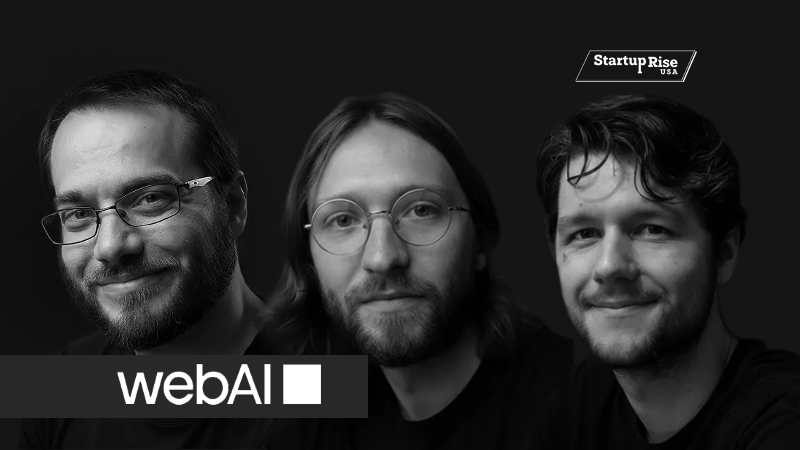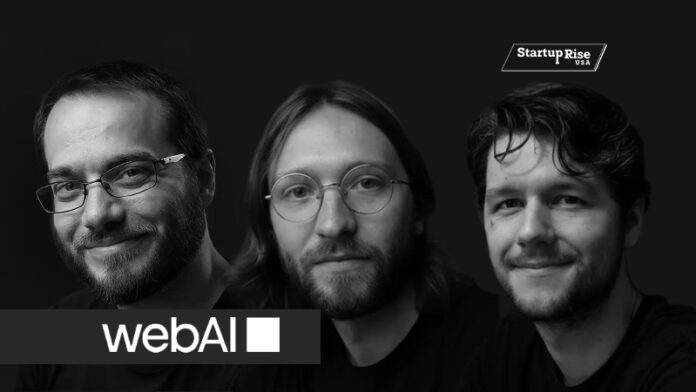
The Problem We All Know Too Well
Open your laptop. Type a query.
Suddenly, hundreds of tabs. Countless articles. An avalanche of data with no clear answer.
This is the internet today: too much information, too little clarity.
In 2022, three innovators—David Stout, Ethan Baird, and Tyler Mauer—looked at this chaos and dared to ask:
What if the web itself could think for you?
That single question sparked the birth of Web AI, a company designed not to replace the internet, but to reimagine how we interact with it.
The Founding Trio: Different Paths, One Dream
David Stout: The Visionary Storyteller
David Stout was always fixated on tackling large, complicated problems. A former software and product designer, he had seen too many professionals buried beneath mountains of research. Whenever he watched analysts or business people lose hours filling in gaps in disparate data, he thought:
“If there was a cleverer way?”
But for David, AI was more than code. That was an opportunity to make something that resembled a real companion — a system that could do the heavy lifting for you and allow you to concentrate on the things that really matter.
Ethan Baird: The Builder Behind the Brains
Where David brought the vision, Ethan Baird brought the technical muscle. With experience in data infrastructure and scalable engineering systems, Ethan had the skills to take wild ideas and turn them into reality.
At Web AI, Ethan became the architect of the core technology: agents that don’t just scrape data, but interpret it, contextualize it, and respond like a human would. He wanted to go beyond automation. His goal was intelligence—AI that could truly understand.
Read Also: From Night Hustle to Global Impact: Amigo AI’s Mission to Scale Expertise
Tyler Mauer: The Strategic Executor
Every great team needs a force of balance. That was Tyler Mauer. While David dreamed big and Ethan built fast, Tyler grounded the mission in strategy, partnerships, and business execution.
Tyler asked the questions that many startups forget: How do we scale? How do we reach the right markets? How do we make this sustainable? His ability to bridge vision with market reality made him the third pillar of Web AI’s foundation.
Together, the three weren’t just co-founders—they were complements of each other’s strengths.
The Spark: Turning Frustration into Innovation
The idea for Web AI didn’t come from a boardroom. It came from frustration.
Everywhere they looked, professionals were drowning in digital noise. Analysts spent weeks compiling reports. Marketers wasted hours sifting through online chatter. Researchers clicked through page after page of links.
The problem wasn’t access to information—it was overload.
The trio realized something profound: the real bottleneck of the internet isn’t data. It’s attention.
If they could build AI that acted like a digital teammate; someone who could read, sort, and synthesize the web on your behalf—they could change the game.
That realization was the birth of Web AI.
The Early Days: Late Nights and Growing Doubts
Like every startup story, Web AI’s beginnings weren’t glamorous.
The first “office” was a collection of laptops in shared workspaces. Their prototypes barely worked. Early AI agents produced clunky summaries or lost context entirely. More than once, an investor asked them: “Isn’t this just Google on steroids?”
But David, Ethan, and Tyler saw something others didn’t.
While big tech companies were obsessed with ads, clicks, and engagement, Web AI had a different mission: understanding.
They believed the web shouldn’t just serve you content—it should serve you meaning.
Fueled by caffeine, doubt, and determination, they coded through nights, tested with friends, and iterated relentlessly.
Storms on the Startup Road
Every journey has turbulence, and Web AI’s was no exception.
Investor Skepticism
Some VCs couldn’t see past the noise. “The problem’s too big.” “Google will crush you.” Rejections piled up. Each one stung.
Technical Roadblocks
The agents had a hard time with nuance. They could fetch data, but understanding tone, context, and intent was much more difficult. Ethan spent weeks debugging models, frequently rewriting entire pipelines for the sake of accuracy.
Privacy Concerns
Storing sensitive data brought with it the inevitable questions: Are AI agents trustworthy with personal and business information? The group leaned into compliance, integrating privacy and transparency as features and not as afterthoughts. They wouldn’t quit despite the storms. Every no was fuel. Every obstacle was a lesson.
Breakthrough Moments
The turning point came in late 2023.
After countless iterations, Web AI’s agents finally hit a milestone: they could autonomously handle nearly 80% of user queries with human-like clarity.
For early adopters—consultants, media firms, research organizations—the time savings were jaw-dropping. Hours of work shrank into minutes. Suddenly, Web AI wasn’t just another AI startup. It was a category creator.
This validation of traction changed the story for the investors. Skepticism turned into curiosity. Curiosity turned into belief. Soon afterwards, Web AI raised its first seed round, allowing the team to expand its talent pool and polish its product.
From Startup to Movement
By 2024, Web AI wasn’t just surviving—it was thriving.
Use Cases Expanded Rapidly
- Consultants used it to crunch reports in record time.
- Media companies leaned on it to track breaking news trends.
- Marketers deployed agents to monitor online chatter and consumer sentiment.
Wherever people needed to transform information into insight, Web AI stepped in.
Global Reach
While their roots were in the U.S., the founders quickly saw opportunities abroad. With multilingual capabilities in development, they began eyeing Europe and Asia, envisioning Web AI as a global intelligence layer for the web.
Cultural Impac
Apart from its technology, Web AI sparked discussions on the future of information. How does it feel when the web begins to work for us rather than work us over? What will it be like when AI really is our digital collaborator? These weren’t just technical questions—they were cultural shifts.
The Road Ahead: Teaching the Web to Anticipate
The founders are clear: Web AI is just getting started.
Their next phase is about moving from reactive AI to predictive AI.
Imagine agents that don’t just answer your questions, but anticipate them. AI that knows your workflow so well it delivers insights before you even ask.
They’re also building for seamless integrations; so Web AI becomes invisible, woven into the tools professionals already use.
And with their eyes on global expansion, they aim to make Web AI a platform that bridges cultures, languages, and industries.
The vision isn’t small:
A world where every professional has a digital twin navigating the internet on their behalf.
Lessons for Builders and Dreamers
The Web AI journey is more than a startup story. It’s a roadmap for anyone chasing big, daunting dreams.
- Pair Vision with Execution. Ideas are easy; building is hard. David, Ethan, and Tyler show that it takes both dreamers and doers.
- Turn Rejections into Fuel. Investor “no’s” aren’t the end. They’re checkpoints on the way to “yes.”
- Make Privacy a Priority. Trust isn’t optional—it’s the foundation of adoption.
- User-First Always Wins. By listening to early adopters, they turned a clunky prototype into a category-defining product.
Their biggest lesson?
Sometimes the simplest question—“What if the internet could think?”—can unlock the boldest revolutions.
A Story Still Being Written
From laptops in shared workspaces to investor-backed momentum, from rejected pitches to global ambitions, Web AI’s journey is still unfolding.
David Stout, Ethan Baird, and Tyler Mauer didn’t just build a company. They built a vision: an internet that empowers instead of exhausts.
Their mission is clear and urgent:
Make the web work for you—not the other way around.
And if their journey so far is any sign, the story of Web AI has only just begun.



